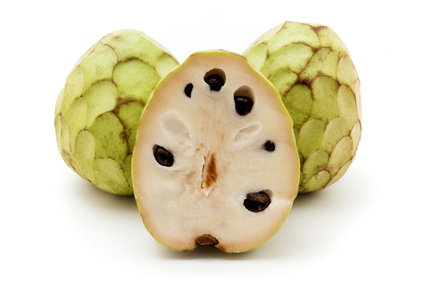
Health Benefits:
Aids in digestion
Aids in red blood cell formation
Aids in weight loss
Anti bacterial qualities
Anti inflammatory
Fights free radicals
Helps control LDL cholesterol levels
Improves hair skin and nails
Increases immunity
Lowers blood pressure
May reduce cholesterol
May reduce risk of cancer
May reduce risk of heart disease
May reduce risk of stroke
May regulate blood sugar
May regulate heart rate
Promotes heart health
Relieves constipation
Nutrition:
Serving size: 1 fruit without skin or seeds; Calories: 176; Fat: 1.6g; Cholesterol: 0mg; Sodium: 16mg; Carbs: 42g; Fiber: 7g; Sugars: 30g; Protein: 3.7g; Potassium: 19%DV; Vitamin A: 0%DV; Vitamin C: 49%DV; Calcium: 2%DV; Iron: 3%DV
Did You Know?
- Cherimoya fruit is a good source of B-complex vitamins, especially vitamin B-6 (pyridoxine). 100 g fresh fruit provides 0.257 mg or 20% of daily-recommended levels
- The cherimoya is a member of the custard apple family, which includes the soursop, sweetsop, and atemoya
- Many people often chill the cherimoya and eat with a spoon, which has another nickname" ice cream fruit"
Ways to Eat:
- Raw
- Chilled
- Juiced
Farming Trivia:
- The plant has been thought to be native to Loja region of Ecuador, bordering Peru, the low rising tropical forests of Central Andean Mountains.
- They are now grown in many Central American countries, Mexico, Hawaii, India, Australia, Spain, Florida and California
- They bruise very easily and are very sensitive to severe cold, so commercial production is mostly local.
- At its natural habitat, cherimoya season lasts from November until May.
Note: Always consult a physician for any specific health questions and concerns. Some of this information may be subject to change should there be any new findings from Federal Health Administration (FHA), Food & Drug Administration (FDA), American Medical Association (AMA), American Cancer Society (ACS), and / or other leading food, nutrition and medical advisors.

